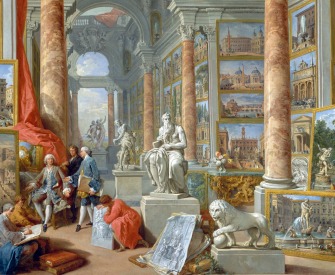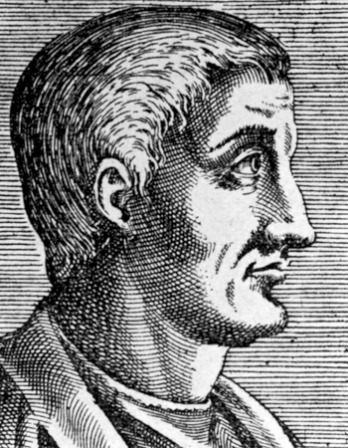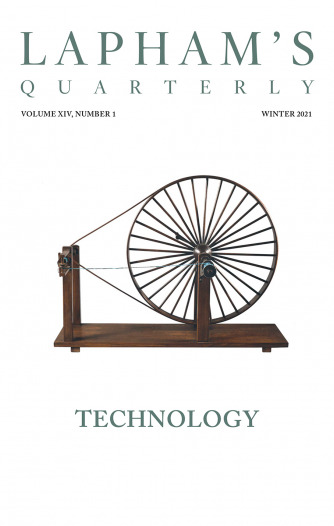What is popularly called fame is nothing but an empty name and a legacy from paganism.
—Erasmus, 1515A Public Man
The sheer gravitational weight of Lord Byron’s fame had the power to distort everything around it.
By Andrew McConnell Stott
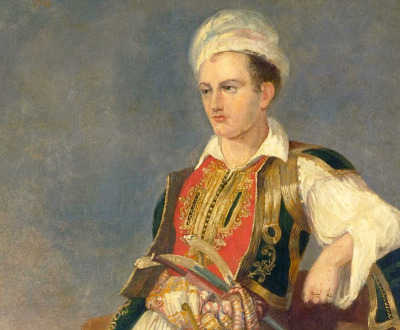
Portrait of Lord Byron by an unknown artist, c. 1830. Benaki Museum.
Francis Gastrell was very annoyed. He had bought a nice new house only to find hordes of uninvited guests tramping through his garden and helping themselves to sprigs and branches from his mulberry tree. These trespasses angered him so much that one day he took up an axe and chopped the tree down, thus removing the inconvenience. The visitors stopped coming, which in turn upset the villagers who relied on their money. They formed a gang, descended on Gastrell’s house, and smashed all his windows. With the score evened, things quieted down for a bit, at least until the town council decided to raise the taxes on the property, thus driving Gastrell into a renewed frenzy. Rather than pay the increased dues, the reverend (for Gastrell was a man of the cloth), chose to vacate the house and dismantle the entire building brick by brick and gable by gable. A fresh stump and a razed plot were all that remained to inform visitors that here had stood New Place, the handsome and spacious manor house that William Shakespeare had bought for his retirement, and where, with his very own hands, he had once planted a mulberry tree.
Gastrell’s spectacularly vindictive act of vandalism took place in 1759, depriving the world of one of the only remaining sites with unambiguous ties to Shakespeare. But it served to mark the advent of literary tourism. Infused with the nascent spirit of romanticism, late-eighteenth-century lovers of literature who desired greater intimacy with their favorite works set off to commune with the spirit of genius as it lingered in place. Writers became objects of fascination, celebrities noted not for their craft or erudition but for their vivid individuality and the expansive range of their passions. For living legends like Voltaire and Rousseau, daily life involved a procession of curious sightseers who came not to speak with them as equals, but to nudge each other and point as if gazing at monuments, which made Rousseau so uneasy he built a trapdoor in his study to escape them. Souvenirs were an essential part of the experience, a sliver of the mundane snatched to unite oneself to the vast infinity of the sublime. Though fairly innocuous in the case of literary gardens, they could also be decidedly ghoulish. The body of the novelist Laurence Sterne was dug up shortly after his death by resurrectionists at the behest of surgeons who prized the opportunity to examine the great wit’s organs. The body was recognized on the slab by horrified students also acquainted with literature. When the body of John Milton was exhumed in 1790 in order to locate the exact site of his grave, it was immediately ransacked for hair, teeth, and ribs and put on display for anyone willing to pay sixpence. The dismantled Milton was eventually put back together, but only after a scandalized antiquarian bought back the remains at an inflated price. The heart of Percy Bysshe Shelley was famously plucked from the flames of his funeral pyre on a beach near Viareggio and squabbled over by Leigh Hunt and Edward Trelawny, the former wishing to preserve it in a jar of wine, and the latter wanting to present it to Shelley’s widow, Mary, who eventually kept it in a drawer of her writing table. Lord Byron had wanted to keep Shelley’s skull, but Trelawny, “remembering he had previously used one as a drinking cup,” only preserved a fragment of it, which is now in the possession of the Pforzheimer Collection of the New York Public Library. It looks exactly like a piece of dried leaf.
Pandava brothers, victors over the Kauravas in the Kurukshetra War, a central story of the Mahabharata, Somnath Temple, Gujarat, India. © Surya Temple, Dinodia, The Bridgeman Art Library International.
Byron had a penchant for keepsakes and mementos, often traveling with a specially made screen that had pictures of his favorite actors on one side and his favorite boxers on the other—ironic given that he felt so devoured by the ravening and persistent intrusions into his private life that he eventually sent himself into exile. “Byromania” (a term coined by his future wife, Annabella Milbanke) swept England after the publication in 1812 of his poetic travelogue Childe Harold’s Pilgrimage, which went on to sell a remarkable twenty thousand copies. It was followed by a series of “Oriental tales” that were also successful—The Giaour and The Bride of Abydos (both 1813), Lara and The Corsair (both 1814), The Siege of Corinth and Parisina (both 1816)—all eminently accessible poems, built around bold, questing narratives and propelled by jogging rhythms that depicted men of “loneliness and mystery” tormented by forbidden knowledge and a threatening secret.
The unprecedented reaction to Byron’s poetry coincided with the demands of intimacy that romantic readers were making upon authors they admired. As Sir Walter Scott would write, Byron was “the first poet who, either in his own person, or covered by no very thick disguise…directly appeared before the public, an actual living man expressing his own sentiments, thoughts, hopes, and fears.” The work became virtually secondary to the man whose own identity was the real achievement, sending London “stark mad,” according to the poet Samuel Rogers, in their efforts to inhabit some small part of him. Men practiced Byronic scowls at their dressing tables, but it was women for whom the work resonated most strongly, drawn to the poet’s fantasies of unconstrained movement that gave voice to freedoms they were otherwise flatly denied. Many went to extraordinary lengths to get near him, propositioning him at the theater, turning up at his house, or disguising themselves as chambermaids. They bombarded him with letters filled with frank confessions and amorous addresses and begged him for souvenirs: locks of hair, signed copies of his works, samples of his handwriting, and even “an occasional place in your lordship’s thoughts.”
Yet for all the adoration transmitted by his readership, Lord Byron was ultimately viewed as more consuming than consumed. From the start there was the suggestion of something supernatural about his fame. His friend and early biographer Thomas Moore remarked how it had been oddly instantaneous, forgoing all “the ordinary gradations,” and simply appearing “like the palace of a fairy tale, in a night.” William Wordsworth (who had his walking stick pried off him by a souvenir hunter and was perpetually battling with tourists who peered through his windows and defiled the bushes at Rydal Mount) condemned the public’s insatiable thirst for “outrageous stimulation,” denouncing Byron as “coarse” and “epigrammatic,” a panderer to the basest artistic urges and secretly insane. (By way of retort, Byron referred to the Lakes poet simply as “Turdsworth.”) Amelia Opie, one of the many women Byron charmed, described him as having “such a voice as the devil tempted Eve with; you feared its fascination the moment you heard it,” a mesmeric quality that critics also found in his verse, which had, according to the critic Thomas Jones de Powis, “the facility of…bringing the minds of his readers into a state of vassalage or subjection.” As with the Byromania, the Byrophobia was the result of the sheer gravitational weight of a fame that had the power to distort everything around it. As one of the earliest beneficiaries of a new kind of entrepreneurial celebrity forged in the furnace of rapid industrialization and no longer dependent on the authority of conquest, church, or heredity, Byron embodied a phenomenon that was new and unnerving in the range of emotions it could elicit and the power seemingly at its command.
The effects of celebrity inevitably bled into Byron’s private life, lending his relationships an unreal quality that blurred the boundaries between the man himself and the Byronism he had been elected to represent, “this melancholy which hath made me a byword.” His affair with Lady Caroline Lamb, the spirited and eccentric wife of a future prime minister, offered an especially lurid proof of the byword’s sexual prowess. Lamb was seduced before she had met Byron at Holland House, an intellectual headquarters for English liberals. Once introduced, she told her diary, “That beautiful pale face will be my fate,” becoming so instantly intoxicated that Annabella Milbanke likened her to a rabid dog: “I really thought that Lady Caroline had bit half the company,” she wrote, “and communicated the Nonsense mania.” Despite being raised to privilege and wealth, Lamb had endured an almost feral childhood, brought up in the wilderness of a mansion with a distant mother and father and little formal schooling in spite of unusual intelligence. From the start of their relationship, Byron and the “evil genius,” as Byron dubbed Lamb, behaved as if they were characters in one of his poems, establishing elaborate games of courtship that included cross-dressing and sex by proxy. She sent him gifts of her pubic hair and asked for his blood by return of post. Byron recoiled at an imagination “heated by novel reading.” Wearying of her histrionics, he took respite in the arms of her rival Lady Oxford, sending Caroline into a fit of near insanity from which it took her several years to recover.
Part of her rehabilitation involved the composition of a novel, Glenarvon, written in secret while dressed as a man. A roman à clef of thinly veiled portraits of the entire Holland House set in which she moved, it was remarkable not only for a sustained emotional pitch that bordered on incoherence, but also for its caricature of the affair in which she portrayed herself as the ethereal waif Calantha and Byron as the Irish rebel Lord Glenarvon. Glenarvon is the prototypical demon lover, part Vicomte de Valmont, part Samuel Richardson’s Lovelace, and easily seen as the forerunner of Emily Brontë’s Heathcliff, stalking ruined priories, howling like a dog at the moon, showing to his victims a face that glowered “as if the soul of passion had been stamped and printed upon every feature.” Drawn inextricably to the powerless Calantha, he announces “my love is death,” while plunging into a sadomasochistic liaison that results in her utter degradation: “Weep,” cries Glenarvon, binding her tighter to him, “I like to see your tears; they are the last tears of expiring virtue. Henceforward you will shed no more.”
Glenarvon was a hit, but not the sole literary representation of Byron’s wickedness. A work of even greater venom emerged from the pen of John William Polidori, the twenty-year-old doctor hired as the poet’s traveling physician on the eve of his self-imposed exile to Europe in 1816. Polidori first met Byron as public suspicion of the poet turned to open contempt after his separation from Annabella. That success had bred a monster was the constant theme of the tabloidlike society gossips scandalized by Byron’s incestuous relationship with his half sister Augusta and by the accusations of sodomy helpfully spread by Caroline Lamb.
The resulting furor afflicted Byron with bouts of mania and disorienting depression. The laudanum he took by way of remedy further complicated his suffering with constipation and anorexia, and when he decided to leave England, his friends refused to let him travel alone. The recruitment of Polidori proved to be more trouble than it was worth. The young man was highly literate, speaking fluent Greek, Latin, French, Italian, and English. He was also an aspiring author, having written a number of poems, political tracts, and tragedies while studying medicine in Edinburgh. Polidori’s father, who taught Italian to well-to-do clients, entertained high hopes and great expectations for his son, but by cramming the young man with philosophy, and Greek and Roman history, he nurtured ambitions that could not possibly be satisfied by the respectable but mundane office of gentleman’s physician. Flashes of such discontent had already been revealed. Having been ordered to medical school, Polidori made an abortive attempt to give up on his studies and run away to Italy to fight on behalf of his patrimonial homeland against the Napoleonic army of occupation. “No doctor ever acquired glory, save amongst doctors,” he wrote to his frantic father. “My ambition aims at general fame: for this I would give life and all. I have but life to sacrifice, and this, who would hesitate to hazard for so noble a prize?”
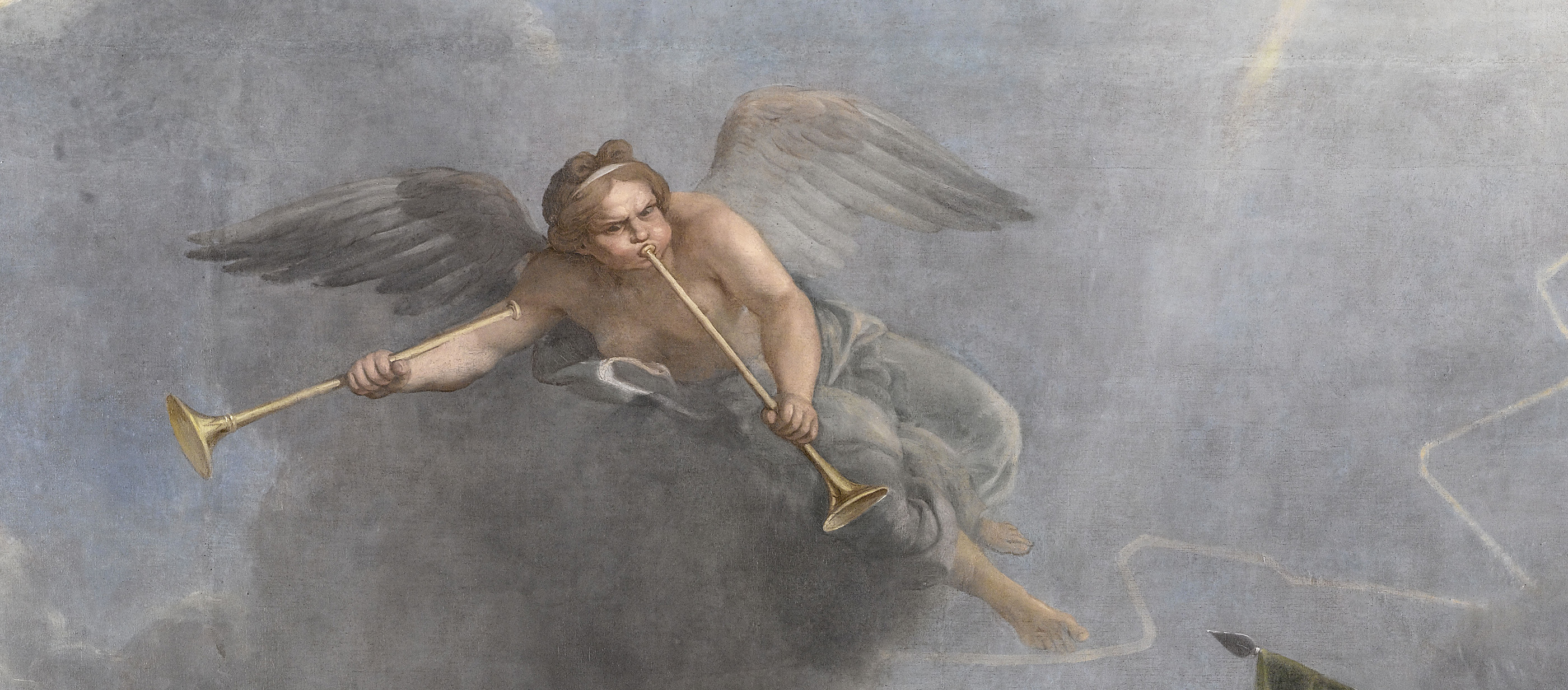
Fame, from Spanish Actions Deflected by the Taking of Ghent (detail), by Charles Le Brun, 1678. Palace of Versailles, Hall of Mirrors, France.
It is unsurprising that a young man willing to die for fame would feel some friction in the company of Lord Byron, but, initially at least, Polidori was keen to express how well they got along, writing from Brussels to his sister Fanny to say that he was “very pleased with Lord Byron—I am with him on the footing of an equal, everything alike.” Two days later, however, he noted their disparity in the eyes of the world, informing his diary that he had been “graciously received” at the home of Mr. Pryce Gordon, “Lord B as himself, I as a tassel to the purse of merit.”
The true nature of their relationship had been established prior to reaching the continent. On the night before their departure from Dover, Polidori invited Byron to read from his own unpublished manuscripts. Byron did so in a mocking tone of voice for the amusement of two of his closest friends, John Cam Hobhouse and Scrope Berdmore Davies, during a spirited evening of farewell. Polidori listened in unsmiling silence, the merriment of his social superiors made merrier by the doctor’s dogged refusal to take a joke.
While traveling in Geneva, Polidori constantly complained to his diary that next to Lord Byron, he seemed nonexistent. “May 28: Went to Madame Einard. Introduced to a room where about eight (afterward twenty)…LB’s name was alone mentioned; mine, like a star in the halo of the moon, invisible.” They met up with Claire Clairmont and the Shelleys, and Byron leased the Villa Diodati to spend a wet summer engaged in speculative conversations and trips on the lake. The proceedings provided Polidori with more to envy. Not only did he have to endure Shelley’s poems, which were far better than his own, he found himself suddenly replaced as Byron’s principal interlocutor. Even more galling, Byron’s health began to improve while his own deteriorated to the point that he was being cared for by his own patient. “Doctor Pollydolly” was rapidly becoming a figure of fun, teased for his stiff manners and exaggerated attachment to honor, which in turn only made him brooding and terse. He sulked and became violent, lashing out at a coachman he accused of insolence, striking Byron’s Swiss servant, collaring a pharmacist and breaking his glasses, and once, while boating, threatening to shoot Shelley dead. Byron released him from his service.
Like Caroline Lamb, Polidori took his revenge by writing up and elaborating the outline of a tale originally conceived by his ex-employer. The result was The Vampyre, a parable of resentful intimacy published in 1819 that recounted the appearance in London of a pale and fascinating nobleman “more remarkable for his singularities than rank,” who incites awe among fashionable ladies by virtue of his melancholy air and “reputation of a winning tongue.” This Byronic stranger known as Lord Ruthven (the name borrowed from Lamb’s Glenarvon), is eventually revealed as “a vampyre!” glutting his thirst for blood on an innocent maiden.
Possessions, outward success, publicity, luxury—to me these have always been contemptible. I believe that a simple and unassuming manner of life is best for everyone, best both for the body and the mind.
—Albert Einstein, 1931Polidori’s book occupies a privileged position in literary history as the first fully realized vampire fiction in English and also the first to imagine the monster as a refined aristocrat and magnetic denizen of assemblies and drawing rooms. It is tempting to view the text as a straightforward allegory of the Byron-Polidori relationship, but as a meditation on the power of celebrity, it presents an emphatic view of fame as a predator that grows strong through the sacrifice of superior values, while simultaneously condemning a celebrity-hungry society that exults in the ephemeral qualities of charisma and talent.
The publication history of Polidori’s tale further testifies to the predatory nature of celebrity. Polidori, it seems, never intended for the story to appear in print, merely writing it for the pleasure of an acquaintance while still in Geneva. The manuscript lay forgotten for three years, at which point it came into the hands of Henry Colburn, who placed it in his New Monthly Magazine as “A Tale by Lord Byron.” The response was predictably lively, and a number of bound editions leapt to market leaving Polidori scrambling to assert his rights as its author. With little motivation for acknowledging the unknown Polidori in Byron’s place, Colburn offered simply a halfhearted nod in a reprint he subtitled “a tale related by Lord Byron to Dr. Polidori,” even insinuating that it was the young doctor rather than himself who was guilty of misrepresentation. Such was Byron’s hold on the minds of his readers, everyone continued to believe the story to be his—even Johann Wolfgang von Goethe, who proclaimed it his best work yet—presumably because they wanted to see it as a kind of admission on the part of the poet, that he saw himself in the same dark terms as they did themselves. Disgusted at his treatment and hoping to claw back some financial reward, Polidori began to prepare his own edition, making a series of alterations to the text that included changing Ruthven’s name to the even more oppressive “Strongmore,” but disillusionment set in, and he renounced literature altogether and began studying to go into the law or the priesthood. A series of misfortunes followed, including a concussion and the incurrence of some gambling debts, and unable to outrun the shadow of the past and embrace his own talents, he took his own life at the age of twenty-five, drinking a beaker of cyanide. “Poor Polidori,” wrote Byron when he heard, “it seems that disappointment was the cause of this rash act. He had entertained too sanguine hopes of literary fame.”
Byron outlived Polidori by a mere thirty-two months, and though his posthumous reputation grew with unmitigated force, his own “literary fame” quickly receded behind the looming shadow of Byronism itself. From the point of his exile to the end of his life in Greece, Byron became increasingly lost in the labyrinth of the Byronic creation, causing him to become coquettish and contrary and seemingly always trying to provoke a reaction. As Lady Blessington wrote of him a year before he died, he “had so unquenchable a thirst for celebrity that no means were left untried that might attain it; this frequently led to his expressing opinions totally at variance with his actions and real sentiments, and vice versa, and made him appear quite inconsistent and puerile.” The fictions of celebrity had come to consume their creator.
